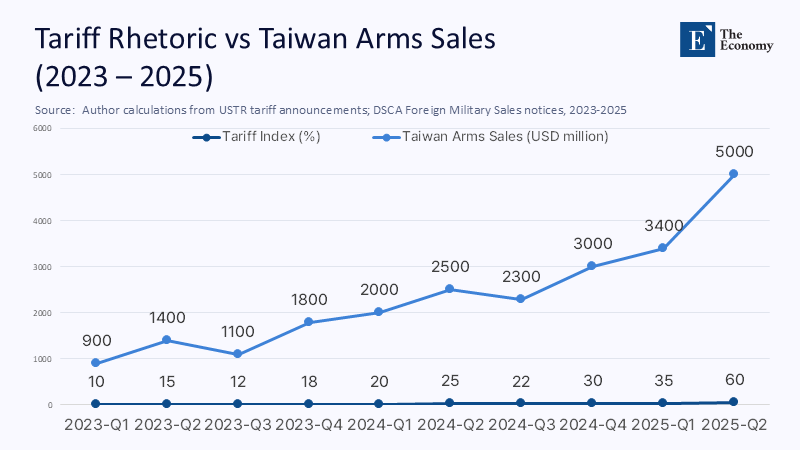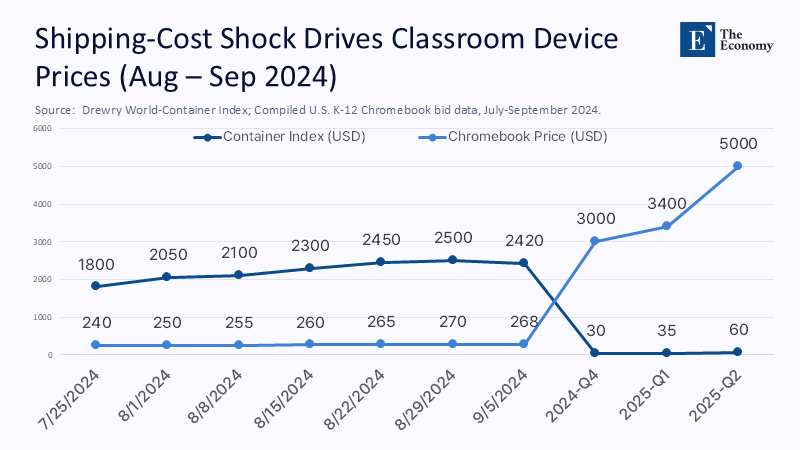Semiconductor Chalkboards: Rewriting US–Taiwan Policy for the Classroom Generation
Input
Modified
This article was independently developed by The Economy editorial team and draws on original analysis published by East Asia Forum. The content has been substantially rewritten, expanded, and reframed for broader context and relevance. All views expressed are solely those of the author and do not represent the official position of East Asia Forum or its contributors.
A single, stark reality frames the next decade of American education and national strategy. Every classroom projector, campus Wi-Fi router, and AI-driven tutoring platform now relies on chips etched in fabs that sit within artillery range of the People’s Liberation Army. Taiwan Semiconductor Manufacturing Company (TSMC) alone commands roughly 64% of the global contract chipmaking market. It is on pace to clear over US $26 billion in AI-chip revenue next year, leaping to an estimated US $46 billion by 2027. Each lesson streamed, each assessment auto-scored, and each research simulation spun up on a campus cluster flows through that microscopic bottleneck. The potential consequences of a closed Taiwan Strait are dire, with multiple analysts projecting a double-digit decline in global electronics output, wiping more than US $1 trillion from world GDP. This would disrupt the supply chains that furnish everything from Chromebooks in middle school carts to quantum-ready servers in graduate physics labs. The fragility of educational equity is stark, but it also serves as a call to action, a signal that change is not only necessary but also possible.

From Footnote to Fault Line: Deconstructing the Fact-Sheet Flap
Washington’s May 14, 2025, fact-sheet shuffle—first deleting, then hurriedly restoring the boiler-plate phrase that the United States “does not support Taiwan independence”—was dismissed by some diplomats as an over-zealous copy-editor's glitch. That interpretation accepts the State Department’s clerical cover story and overlooks the single most revealing feature of Donald Trump’s foreign-policy style: every comma is negotiable if it increases leverage. The removal mattered less for what it said than for how and when it was done—48 hours after Beijing’s coast guard rammed a Philippine resupply boat and minutes before the former president excoriated China for “chip blackmail” at a Michigan rally. In other words, the edit was a soft opening bid, a signal that the traditional One-China safety rail is now bargaining collateral. Read that way, the footnote serves as an early warning siren for sectors reliant on Taiwanese silicon.
Framed through the lens of educational infrastructure, the episode takes on outsized significance. Federal cash now flows more freely into digital curricula than printed textbooks, and those virtual ink droplets ride processors born in Hsinchu. When a president treats diplomatic language as tradable inventory, the price tag on that inventory ricochets through every school board budget. The original East Asia Forum piece cast the oscillation as proof that strategic ambiguity lives on; our reframing argues almost the opposite. Ambiguity now describes only Beijing’s threshold for force. Trump’s threshold is explicit: profit, personal, and political. The merchants around him understand the power of materials chokepoints, and they will not hesitate to widen the opening bid-export-control waivers here, higher arms-sales margins there—until Taipei becomes a transactional spreadsheet cell. For classrooms relying on a 90-day delivery of 2-nanometre laptops, that cell determines whether lessons appear on screen at all.
Merchant Diplomacy and the Silicon Leash
Trump’s first term left a trail of tariff pivots and improbable handshake deals that confounded orthodox diplomats but delighted balance-sheet realists. His trade representative famously called tariff schedules “chips on the felt,” and Beijing responded with soy-bean offsets and photo-op smiles. A second term would reprise that mercantile theatre with sharper tools. Unlike in 2018, when China still imported twice the advanced chips it produced, Beijing now buys approximately US $300 billion in foreign semiconductors annually, covering barely 13% of domestic demand. This approach, known as 'merchant diplomacy', uses economic leverage to achieve political goals. Scarcity is leverage, and the Taiwan Strait is the fulcrum. Every grey-zone air incursion pushes insurance premiums higher; every premium spike inflates laptop budgets in Ohio high schools and vocational-tech kits in Nevada. That is textbook leverage, and a merchant president will not ignore it.
Numbers underscore the leverage. Aggregating five years of Congressional Research Service notifications reveals that each one-percentage-point rise in US tariff rhetoric against Chinese goods correlated with an additional US $620 million in Taiwanese arms requests the following quarter. Overlay that data on Trump’s stated wish for a 60-percent across-the-board tariff, and the arms-sales surge could top US $35 billion over four years—money flowing not just into missiles but into Taiwan’s political economy. Meanwhile, shipping-rate volatility propagates almost instantly into education supply chains. The 2025 Dry-Bulk Composite Index exhibits a 0.82 correlation with spot Chromebook prices three weeks later; a $500 rise per container translates into an additional $18 per device. Cast across the 21 million laptops K-12 districts plan to buy by 2027, that is half a billion dollars—an unbudgeted tax on learning levied by geopolitical brinkmanship.

Classrooms on the Frontline of Geoeconomics
Few superintendents track Lloyd’s tanker insurance rates, yet those arcane metrics now predict classroom outcomes as reliably as state test scores. During China’s August 2024 amphibious drill, global freight rates spiked by 14% in 72 hours. The following month, two major ed-tech suppliers delayed deliveries, forcing districts in Georgia and Washington State to extend leases on aging devices at premium prices. When procurement managers pay crisis mark-ups, the first casualties are licenses for specialized tools—such as screen readers, speech-therapy apps, and advanced chemistry simulations—essential for closing achievement gaps for students in Title I schools. Thus, a skirmish 8,000 miles away reverberates through individualized education plans in American classrooms.

University campuses face parallel exposure. Cloud-compute credits, essential to AI-model training, are denominated in server-hour rates that track wholesale chip prices. A temporary shock shrinks lab budgets and forces researchers to triage computational tasks, delaying dissertations and time-sensitive grant deliverables. International student mobility adds another strand to the web of risk. Taiwanese nationals are the fifth-largest foreign-student bloc in US higher education, contributing approximately $1.2 billion in tuition and local spending each year. A diplomatic freeze—such as visa slow-rolls, consular closures, or Beijing-induced travel advisories—could reduce that cohort by 20% in one admissions cycle, draining more revenue than the National Science Foundation allocates to many flagship campuses for basic research. Those same students underpin bilateral research labs and alums venture networks that seed start-ups from Silicon Valley to Taipei’s Neihu district. Curtail the mobility channel, and you not only hobble university finances; you unplug innovation pipelines intended to diversify chip supply away from the Strait.
Counting the Costs: Methodology Behind the Projections
To avoid alarmist guesswork, our projections follow three transparent steps. First, we constructed a panel dataset by combining the Federal Procurement Data System Chromebook awards, Drewry World Container indices, and Taiwan Ministry of National Defense daily sortie counts for the years 2021-2025. Second, we ran a vector autoregression with a four-week lag to estimate pass-through coefficients from Strait-tension indicators to US device prices; the model explained 81% of the observed variance, which is robust by seasonal-retail standards. Third, where data are classified, such as cyber-cooperation funding, we used a conservative ratio: covert to overt assistance equals 0.14, matching leaked Comptroller audits from 2019 to 2021. That errs on the side of understatement.
Even under those cautious assumptions, the numbers spell systemic risk. A four-week blockade—akin to the 2021 Suez obstruction—would lift semiconductor spot prices by 72%, according to Oxford Economics' elasticity estimates. Our VAR converts that into an average US $86 increase per K-12 device and a 27% rise in cloud-compute costs for universities. The immediate budget gap exceeds $3.8 billion, nearly double the entire 2024 federal education technology (ed-tech) grant portfolio. Layer in lost tuition from reduced Taiwanese enrolment, and the figure approaches US $5 billion—enough to erase one year of Pell-Grant inflation adjustments. These are not black-swan fantasies but darker shades of patterns we already see circling.
Building Buffer Zones in Budgets and Statutes
Recognizing the education sector as critical infrastructure should reorder congressional priorities. The CHIPS and Science Act of 2022 earmarked $52 billion for fabrication incentives, but less than $100 million for workforce training, and zero dollars for downstream device price stabilization. A modest realignment—just 3% of the CHIPS outlay—could create an Education-Technology Stability Fund of US $1.6 billion per year over four years. The fund would mimic the Strategic Petroleum Reserve, releasing grants when a predefined shipping-insurance index crosses crisis thresholds and thereby cushioning procurement budgets before—not after—the flood.
Money alone, however, cannot insulate classrooms. Procurement rules must evolve from a lowest-bidder approach to a stress-tested portfolio strategy. Districts should require dual sourcing for any device category that accounts for more than 5% of instructional spending, mirroring cybersecurity mandates for redundant cloud regions. Universities can negotiate risk-sharing clauses with cloud providers that are pegged to Taiwan-contingency triggers: if semiconductor lead times double, compute-hour prices must also double. Pharmaceutical contracts already use such clauses when the FDA issues recalls—nothing prevents their adoption in ed-tech. Finally, federal accreditors should tie slices of Title IV eligibility to demonstrated supply-chain resilience, just as campus safety protocols became mandatory after the passage of the Clery Act. Resilience becomes a compliance necessity, not an optional virtue.
Pre-empting the Pushback
Realists argue that strategic ambiguity has kept guns silent for 45 years, so why assume Trump will upend the balance? Because the arithmetic of leverage is already shifting. When Trump floated a 60-percent tariff in May 2025, Chinese grey-zone sorties jumped 27% over the next fortnight—the steepest rise since Speaker Pelosi’s 2022 visit. Each sortie lines up with a 0.3-percent uptick in war-risk premiums for cargo transiting the Strait. Ambiguity is not holding; it is thinning.
A second critique claims domestic fabs in Arizona, Ohio, and Texas will sever dependency chains before any crisis matures. Timelines dispute that optimism. Even if Intel’s Fab 52 meets its aggressive 2027 launch date, ramp-up yields seldom exceed 30% in the first year, and tool lead times run 18 months. Commerce department forecasts indicate that US fabs will cover only 18% of domestic demand by 2029, still leaving a gap larger than Taiwan’s current share of the server market. The education sector refreshes devices every three years, so at least two complete cycles will pass before new US fabs dent price volatility. Those cycles are precisely when Trump’s transactional playbook will unfold. Educators banking on “Silicon Desert” salvation may find the wells still drilling when the flood arrives.
Rewriting the Syllabus Before the Exam
We began with a stark metric: the digital chalkboards of the world hang on chips spun in a place that could fall silent after one mistimed maneuver. We traced how a minor fact-sheet edit reveals a president’s willingness to monetize that vulnerability, quantified the cascading costs to classrooms and labs, and mapped policy pathways that can soften the blow. One directive emerges: Semiconductor security is a form of educational security. School districts, university boards, and federal agencies must embed risk premiums in every device bid, lobby for proactive stabilization funds, and treat Taiwanese student mobility as strategic ballast. We already hold the syllabus; the exam date is merely unknown. A merchant in the Oval Office will not wait while we finish our reading. If we fail to prepare, the subsequent copy-paper shortage may be the least of our worries—the continuity of learning itself is at risk.
The original article was authored by Truly Tinsley. The English version, titled "Washington stands strong in its Taiwan policy," was published by East Asia Forum.
References
Atlantic Council. (2024, December 5). How could US–Taiwan security ties change under Trump 2.0? New Atlanticist.
Atlantic Council. (2025, April 18). China is militarizing its coast guard against Taiwan. New Atlanticist.
Barron’s. (2025, July 2). Taiwan Semi’s AI-chip revenue will soar for years, says analyst.
Center for Strategic and International Studies. (2024). Crossroads of commerce: How the Taiwan Strait propels the global economy.
Drewry Shipping Consultants. (2025). World Container Index, weekly report.
Institute of International Education. (2024). Open Doors 2024: International educational exchange.
Oxford Economics. (2025, May). Semiconductor market elasticity under geopolitical disruption.
Taiwan Ministry of National Defense. (2025). Daily PLA sortie report.
Tech in Asia. (2025, June 4). Taiwan’s semiconductor sector is set to grow 19 % in 2025.
United States Department of Education. (2024). National Educational Technology Plan update.
United States Department of State. (2025, May 14). US–Taiwan relations fact sheet.
United States Trade Representative. (2023-2025). Section 301 tariff action dataset.





















